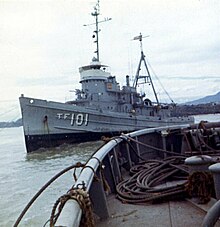Beach Jumpers
This article includes a list of general references, but it lacks sufficient corresponding inline citations. (March 2011) |
Inspired by British tactics
Lieutenant
When he returned to the U.S., Fairbanks presented his idea for a unit of men trained to conduct tactical cover, diversionary and deception missions to Admiral
Volunteer requirements
Beach Jumper volunteers had to meet four general requirements: no
Their identities and activities were very highly classified, since the slightest leak of information could ruin even brilliant deceptions. Their early basic mission was "To assist and support the operating forces in the conduct of Tactical Cover and Deception in Naval Warfare." To accomplish it, they learned to simulate very large amphibious landings with very limited forces. Using specialized deception equipment, a few dozen Beach Jumpers could make the enemy believe they were a 70,000-man amphibious landing force, when in fact that force would be elsewhere, usually a great distance away.
Unit organization
The Beach Jumpers got their name because of their ability to quickly hit the beach and confuse the enemy with harassment and deception operations. During a high level conference, someone stated that the purpose of the Beach Jumpers' work was "to scare the be-jesus out of the enemy." The term "BJ factor" was used thereafter in their planning, and is said to have inspired the cover name Beach Jumpers.
Action during World War II
Beach Jumpers saw much action in World War II. Their first operation was in Operation Husky. On the night of 10 July 1943, Beach Jumper Unit 1 (BJU 1) was ordered to conduct a diversion off Cape San Marco, 100 miles west of the HUSKY landing area. The first attempt was recalled due to hazardous seas. On D+1, the weather was better and the operation began at 22:00. At 3,000 yards off shore, three of the ASRs prepared their heaters, one ASR proceeded a thousand yards ahead and began to lay smoke. As the sound boats prepared to make their run parallel to the beach, a searchlight from Cape San Marco illuminated the area, accompanied by small arms and artillery fire. At 02:30 the sound boats were ordered to secure their heaters and approach the beach, which they did, firing guns and rockets. All boats retired on a course back to their home port at Pantelleria, Sicily.
To keep the Germans' attention, the unit was ordered to conduct another operation on the night of 12 July 1943, using all available craft. This time the shore batteries were completely alerted. The Germans were convinced that a landing was about to take place. Salvos of six-inch and smaller guns were thrown at the boats. The operation was a success and no casualties were sustained.
Operation Husky accomplished complete surprise due to the uncertainty created in the minds of some German commanders by the diversions and deception operations. BJU-1 was responsible for an entire German Reserve Division being held in place, as the German command was unsure where the actual landing would take place.
Beach Jumpers continued to work successfully in the
Shortly after the end of World War II, all Beach Jumper Units were deactivated.
Service in Cold War, Vietnam
Beach Jumpers were reactivated in 1951, in spite of the objections of those who questioned the worth of a deception unit in more sophisticated times. A Beach Jumper unit was given a chance to prove its worth when an important training exercise was being planned. The Beach Jumpers knew that fleet communications from the force commander to ships at sea were relayed through radio Washington. Pretending to be the force commander, they sent a message, via Radio Washington, ordering every ship's commanding officer to report to the flagship the next morning to discuss terminating the exercise. The next morning at least half of the commanding officers were aboard the flagship in a state of mounting confusion and anger. There were no more doubts about the value of the Beach Jumper program.
Through the late-1950s and into the early-1960s as the
Several Beach Jumper teams were active in the

Other Beach Jumpers operated under the cover name "Yankee Station Special Surveillance Unit", aboard fleet tugs such as the
Retirement
The Beach Jumper name was retired in 1972, and the Beach Jumper mission was assigned to Fleet Composite Operational Readiness Group One (FLTCORGRU 1). In 1986, Fleet Tactical Deception Group Pacific (FLTDECGRUPAC) and Fleet Tactical Deception Group Atlantic (FLTDECGRULANT) were formed, with the mission of "Assisting Commanders in the planning and conduct of tactical military deception operations."
Former Beach Jumpers are eligible to join the U.S. Navy Beach Jumpers Association and to be Associate Members of the UDT-SEAL Association. Many Beach Jumpers went to their graves without ever revealing, even to their wives and children, what they had done in the Navy.[citation needed]
References
- ^ a b "U.S. Navy Beach Jumpers". Retrieved 29 January 2012.
- ISBN 9780275938000.
Further reading
- Dwyer, John B. (1992). Seaborne Deception: The History of U.S. Navy Beach Jumpers. New York: Praeger. ISBN 0-275-93800-X.
- Dwyer, John B. (1998). Commandos From The Sea: The History of Amphibious Special Warfare in World War II and the Korean War. Boulder, Colorado: Paladin Press. ISBN 0-87364-960-5.
- Holt, Thaddeus (2004). The Deceivers: Allied Military Deception in the Second World War. New York: Scribner. ISBN 0-7432-5042-7.
